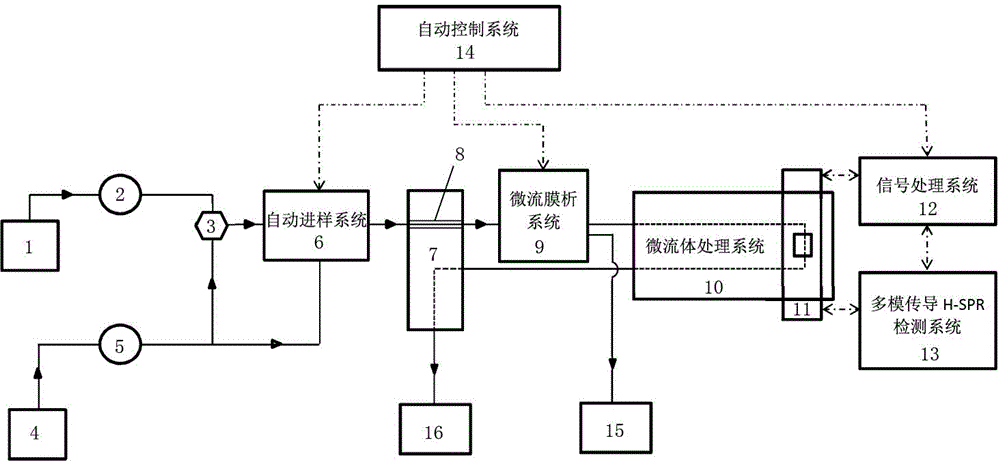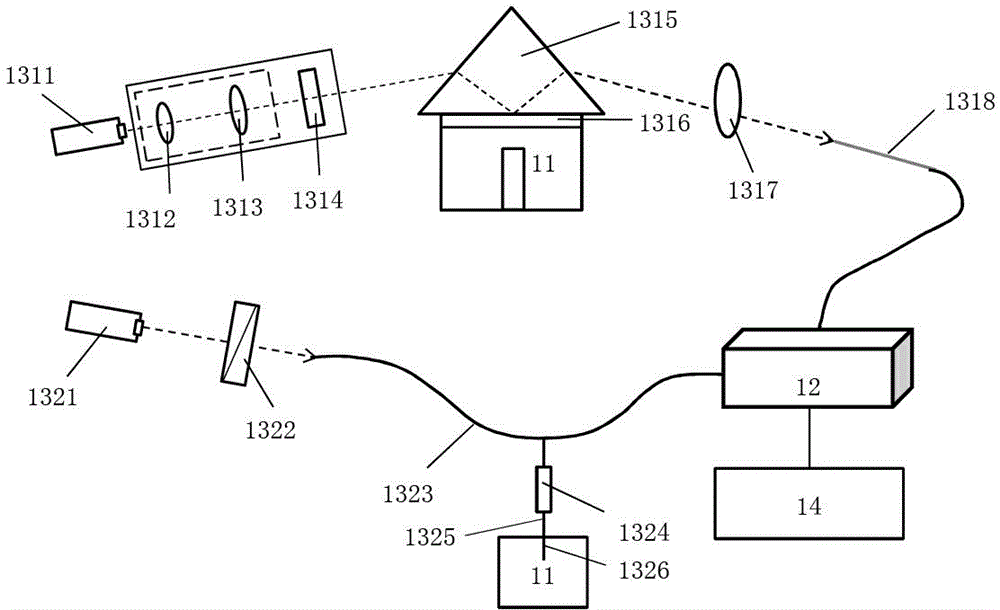On-line purified multimode conduction surface plasma resonance spectrometer
A technology of plasmon resonance and conductive surface, which is applied in the direction of instruments, scientific instruments, measuring devices, etc., can solve the problems of large differences in concentration composition, lack of sample pretreatment function, and inability to meet the number of samples, etc., to achieve rapid detection and high-pass Quantitative testing, to achieve the effect of accurate quantitative detection
- Summary
- Abstract
- Description
- Claims
- Application Information
AI Technical Summary
Problems solved by technology
Method used
Image
Examples
Embodiment 1
[0025] See attached figure 1 As shown, an online purification multi-mode conduction surface plasmon resonance spectrometer includes an automatic sampling system 6, a micro-membrane dialysis system 9, a multi-mode conduction detection system 13, a microfluid processing system 10, a signal processing system 12, and automatic control System 14. The front end of the automatic sampling system is injection valve 3, the back end is injection interface 8, and the front end of injection valve 3 is sample transfer pump 2. Sample transfer pump 2 is responsible for the transfer of sample 1 and mobile phase transfer pump 5 in the automatic sampling system. The mobile phase 4 responsible for maintaining a stable flow rate flows over the surface of the sensor chip or the multi-probe optical fiber array 11. The mixed liquid composed of the mobile phase and the sample is delivered to the sampling interface 8 at the front end of the micro-membrane dialysis system 9 through the automatic sampling...
Embodiment 2
[0027] See figure 2 with image 3 As shown, the multi-mode conduction detection system 13 includes light sources 1311 and 1321, a prism sensing assembly 131, an optical fiber sensing assembly 132, and an optical sensor 12. The optical sensor 12 is shared by the prism sensing assembly 131 and the optical fiber sensor 132; the prism sensing assembly The light source 1311 and the optical fiber sensor component light source 1321 use halogen tungsten light source; the prism sensor component 131 is a cylindrical prism 1315, its cross section is an isosceles triangle, the bottom surface is plated with a flat metal reflective film 1316, and the waist surface is respectively plated with incident height Reflective film and outgoing high-reflection film; optical fiber sensing assembly 132 includes optical fiber sensing assembly. The light source 1321 is connected to the input end of the Y-type optical fiber coupler 1323 via the P-type polarizer 1322, and the output end of the Y-type optica...
Embodiment 3
[0029] See Figure 4 As shown, a multi-mode conduction surface plasmon resonance spectrometer terminal reflection optical fiber sensor 1326 includes a core 13262, a micro mirror 13261, a metal layer 13263, and a specific probe fixing film 13264 on the outer layer of the metal layer 13263. The light emitted from the light source 1321 of the optical fiber sensor assembly passes through the P-type polarizer, and then is transmitted from the input end of the Y-type fiber coupler to the terminal of the sensing fiber 1325. The reflective fiber surface plasma sensor 13261 is at the interface between the metal layer 13263 and the core 13262 Surface plasmon resonance occurs at the place where the resonant light is transmitted to the micro-reflecting mirror 13261 and is reflected back along the original path.
PUM
 Login to View More
Login to View More Abstract
Description
Claims
Application Information
 Login to View More
Login to View More - R&D
- Intellectual Property
- Life Sciences
- Materials
- Tech Scout
- Unparalleled Data Quality
- Higher Quality Content
- 60% Fewer Hallucinations
Browse by: Latest US Patents, China's latest patents, Technical Efficacy Thesaurus, Application Domain, Technology Topic, Popular Technical Reports.
© 2025 PatSnap. All rights reserved.Legal|Privacy policy|Modern Slavery Act Transparency Statement|Sitemap|About US| Contact US: help@patsnap.com



